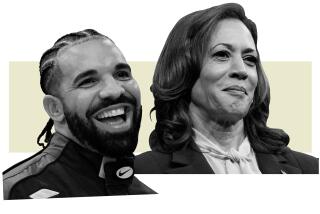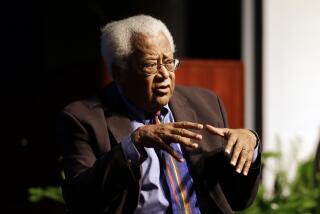When King Was Still a Prince : THE PAPERS OF MARTIN LUTHER KING JR. Volume I: Called to Serve, January 1929-June 1951 <i> Edited by Clayborne Carson, Ralph E. Luker, Penny A. Russell</i> , <i> (University of California Press: $35; 484 pp.) </i>
More than any other 20th-Century American leader, Martin Luther King Jr. is the symbol of and synonym for the struggle against segregation. The ideal of integration wears his face. With canonization, the private man has become a cultural object, difficult to grasp in his individuality, in his humanness, and in the minutiae of his daily life. Yet these are the very foundations from which the public life--the world-shaking career--arises. We wonder: What sort of student was he? What were his intellectual dilemmas? What was the most significant moment of his adolescence?
Not all of these questions are answered in “The Papers of Martin Luther King Jr.,” but the huge library of scholarship on King is enriched, and readers will be enlightened, by the dense compilation of juvenilia and documents presented in this first of 14 volumes planned by the University of California Press. Subtitled “Called to Serve, January 1929-June 1951,” this opening chapter spans the years from King’s childhood through his student days at Crozer Theological Seminary, and includes not only a lengthy introduction on the history of his family but also a genealogy chart, correspondence with his parents, early photographs, chronology, his Graduate Record Examination scores, college term papers and letters of reference.
What emerges from this wealth of research is an intellectual and emotional portrait of young Martin. It is a fascinating depiction of how powerfully--and positively--the black Baptist tradition of social-gospel Christianity shaped character early in this century. The product of three generations of preachers, Martin was nurtured in Atlanta’s Ebenezer Church, in a black community proud, pious and progressive, and by a demanding father who said of segregation, “I don’t care how long I have to live with this system, I will never accept it.” His family, in other words, were black Brahmins in Atlanta. But King Sr., who talked politics at the dinner table, counseled his children against feelings of class superiority, and Martin did manual labor and delivered newspapers as he grew toward adolescence during the Great Depression.
Little wonder, then, that the pastor’s first son, of whom so much was expected, would as a high school student win an oratorical contest sponsored by the black Elks in 1944. His speech on “The Negro and the Constitution” startles us with its elegance and foreshadows the electrifying speeches to come in his 20s. “My heart throbs anew,” he wrote, “in the hope that, inspired by the example of Lincoln, imbued with the spirit of Christ, they will cast down the last barrier to perfect freedom. And I with my brother of blackest hue possessing at last my rightful heritage and holding my head erect, may stand beside the Saxon a Negro, and yet a man!”
Race politics was in his blood. Reading through the documents assembled here, we are hard-pressed at times to find signs of a “regular” childhood, one of mischief and uncertainty, adventurousness or rebellion. On the contrary, young Martin seems programmed from birth to be the perfect son, the lovely boy singing “I Want to Be More and More Like Jesus” in his parents’ church, the privileged and sheltered lad--a little boring--seldom at odds with the historical mission of his class and kin.
In the same year as his “Constitution” speech, Martin spent his summer working on a Connecticut tobacco farm with Morehouse College students. We expect the son of the “best-paid Negro minister” in Atlanta and the grandson of A. D. Williams, who as a child preached “the funerals of snakes, cats, dogs, horses or any thing that died,” to move to the head of this group. Martin does not fail us. “I am the religious leader,” he wrote to his mother. “I have to speak on some text every Sunday to 107 boys; we really have good meetings.”
But despite paternal direction and precociousness, Martin was not altogether his father’s son. He never experienced the “crisis moment” that led to religious conversion; he entered his teens uncomfortable with the emotionalism of fundamentalist Baptist services. By age 16, when he enrolled at Morehouse College, he was more interested in cutting loose and socializing, now that he was away from home, than in studying. “The academic record of Martin Luther King Jr. in Morehouse College is short of what may be called ‘good,’ ” wrote one of his teachers in a letter of reference. Another confessed, “Mr. King has a quality grade-point average of 2.48, which is virtually midway between a C and B average.”
King was an “ordinary,” underachieving student his first three years at Morehouse, and vacillated--like so many undergraduates--between choosing a career as a lawyer or a doctor. His increasing conflict between the intellect and emotional fervor, between the head (science) and heart (faith), held him back from following in his father’s footsteps as a minister: “I wondered whether religion, with its emotionalism in Negro churches, could be intellectually respectable as well as emotionally satisfying.” At last, aided by the liberal theologians he met at Morehouse, he found models he could emulate. Clear about his career by age 19, he entered Crozer Theological Seminary and, as he wrote to his mother, never went “anywhere but in these books.”
At Crozer, he was hypersensitive about defying racial stereotypes. “If I were a minute late for class, I was morbidly conscious of it and sure that everyone noticed it. Rather than be thought of as always laughing, I’m afraid I was grimly serious for a time. I had a tendency to overdress, to keep my room spotless, my shoes perfectly shined and my clothes immaculately pressed.”
“Called to Serve” gives us a great many of the essays that Martin wrote in seminary. In these papers he surveyed all of Western philosophy from Plato to Jacques Maritain, struggling mightily and, I believe, brilliantly to synthesize his Baptist roots in Ebenezer and liberal theology and the personalism of Edgar S. Brightman. While holding firmly to a rigorous, scientific approach to religious studies, he wrote in his essay, “The Christian Pertinence of Eschatological Hope” that “the kingdom of God will be a society in which all men and women will be controlled by the eternal love of God.”
Martin was one of 11 blacks in a student population of more than 90 at Crozer; he became student body president and class valedictorian. By the time he was ready to apply for graduate work at Boston University, his professors could write, “His work is of the highest grade,” and, more prophetically, “He will probably become a big strong man among his people.”
Creator and creature of history, publicly clear yet privately elusive, the soul where American racial politics and belief in the Christian millennium are one--this is the young King of “Called to Service,” a book that serves his legacy well and whets our appetite for the 13 volumes to come.
More to Read
Sign up for our Book Club newsletter
Get the latest news, events and more from the Los Angeles Times Book Club, and help us get L.A. reading and talking.
You may occasionally receive promotional content from the Los Angeles Times.









